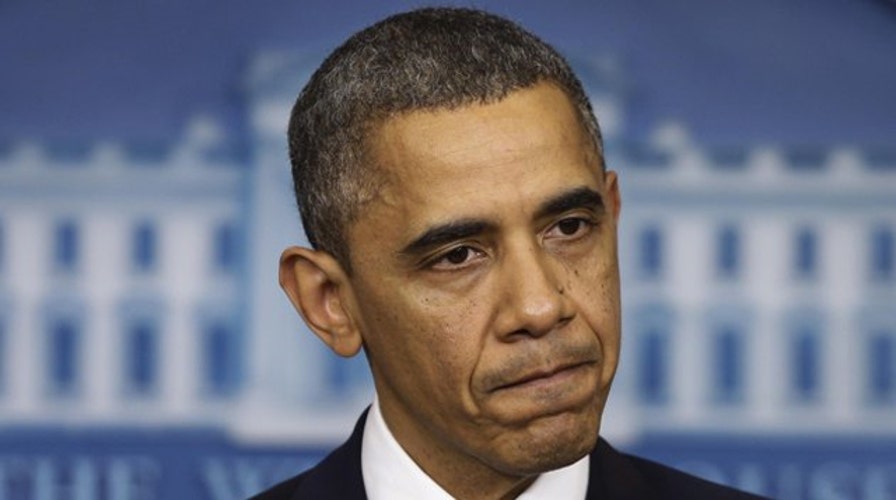Focus on income inequality sparks debate over Obama's policy
President to blame for income gap?
Is income inequality really the number one challenge facing this country? That’s what President Obama and his acolytes have told us, citing a “dangerous and growing” divide between those at the bottom of the ladder and those at the top.
Never mind that his claim is undermined by numerous economists (including left-leaning Jared Bernstein) who have failed to link income inequality with slow growth. More important, the reality is that the gap between richest and poorest in the United States actually dropped 1.8% between 1993 and 2009. Hard to believe, isn’t it? But it’s true.
Those denouncing a rise in income inequality rely on the “Gini coefficient” – a calculation that tracks the gap between richest and poorest over time – to make their case.
[pullquote]
As pointed out in a 2012 study by Lee Ohanian and Kip Hagopian for the Hoover Institute, that measure does not include those payments and transfers that have reduced poverty in our country.
The War on Poverty has been fought with the SNAP program, the Earned Income Tax Credit, Medicaid, taxes and other equalizers. Those efforts are why, as Obama pointed out in a recent speech, poverty has declined in the U.S.
Indeed, the U.S. poverty rate dropped from 26% in 1964 to 16% today; the decline for retirees is even more remarkable – from 35% to 9%, thanks to Medicare, Social Security and other programs targeting seniors.
In all, we have spent an estimated $20 trillion alleviating poverty over the last fifty years. And that doesn’t include Social Security and Medicare. We also have one of the most progressive income tax systems in the developed world. All in all, we have made great strides aiding our poorest citizens.
What is worrisome, and what Democrats and Republicans alike must address, is the scarcity of good jobs available to lower and middle-income workers. This is the defining challenge of our times.
Mr. Obama, who has no experience in or affection for the world of trade and commerce, has no clue how to fight the twin challenges of automation and globalization.
He’s not alone. Across the developed world, policy makers are struggling to provide jobs.
President Obama (and his followers like New York Mayor Bill de Blasio) would rather focus on bogus claims of income inequality because it arouses politically useful resentments and energies, and because he has a solution: raise taxes on the rich. Or, gerrymander a quick fix by mandating higher minimum wages.
Unfortunately, economics will out; higher wages in our competitive world lead to lost jobs when workers can be replaced by machines.
Or, when businesses cannot afford the higher pay, which recently led to the firing of workers at the Resorts World Casino in Queens. Their union had pushed through a wage hike that nearly doubled their pay; their jubilation was short-lived. The employer could not afford the new wage scale, and fired the workers.
At a recent tech conference hosted by ISI Group in New York, speakers described some of the marvels on the horizon: driverless cars, computerized tax preparation, complex analysis performed by machines – in other words, ongoing digital encroachment into human activities.
Andrew McAfee, author of "Race Against Machines," noted that for three decades following World War II, income, productivity, GDP and income growth had moved in lock step.
In the 1980s, that started to change as workers in the developed world suddenly faced competition from those in China and other low-wage regions, and as technology began to steal jobs. Median income started to lag GDP and productivity; the average worker in the U.S. began to fall behind.
At the same time, the gap in earning power between the least and the most educated began to widen. As McAfee pointed out, only people with at least a college degree have increased their earning power in recent years.
There is no stopping this trend. And, it is not just in the U.S. As McAfee noted, there are fewer manufacturing workers in China today than there were a decade ago.
Is the future bleak? Not according to Steven Kotler, author of "Abundance." He reminds us that over the past century humankind has enjoyed huge gains – in child mortality, longevity, income, cheaper food, low-cost transportation and electricity.
He promises that the best is yet to come. Because tech change is exponential and not linear, over the next 100 years he foresees not a century of progress, but more like 20,000 years of progress.
Forces such as infinite computing, synthetic biology, 3D printing, online education, nanotechnology, artificial intelligence- all these and others will help us overcome water shortages, contagious diseases, pollution – and a billion more people will be caught up in the global economy.
Kotler’s optimism may be warranted, but it doesn’t mean that the transition is easy. The advent of low-cost online education – available to the masses – will be a game changer, but it won’t help an unemployed steelworker in Pittsburgh pay his mortgage this year.
Finding a cure for Alzheimer’s is surely desirable, but won’t help an out-of-work teacher afford health care.
There are too many people without jobs in the U.S. The most recent jobs report poured salt on the wound, as few new jobs were created, 347,000 discouraged Americans quit looking for work, and the labor-force participation dropped again -- to a 36-year low. This is the defining challenge of our time. What is President Obama going to do about it?

